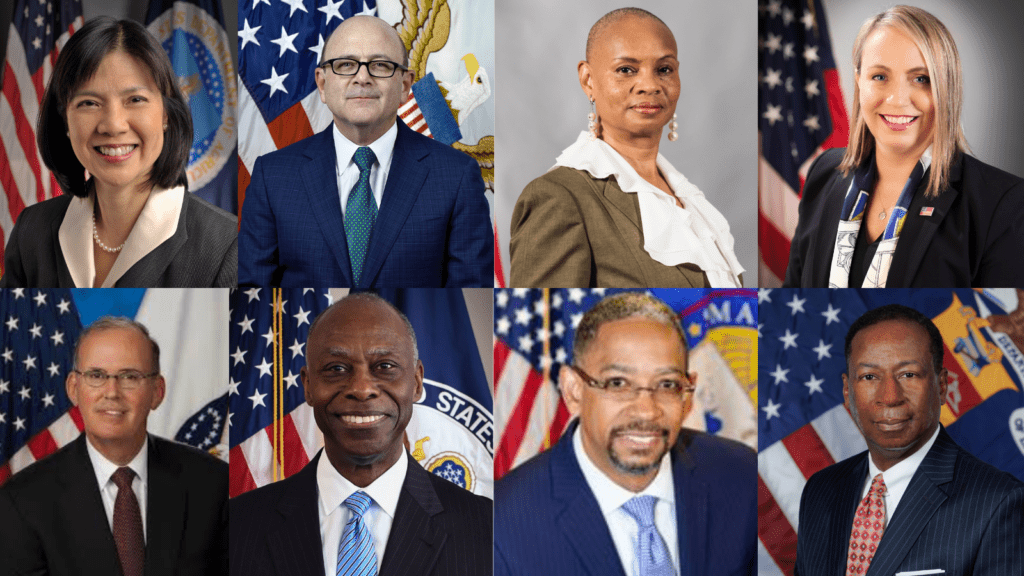
Greg Gutfeld calls Bruce Springsteen “a pussy”
May 15, 2025
If Nabokov Went to Comicon…
May 16, 2025The Presidents and the People
Five Leaders Who Threatened Democracy
and the Citizens Who Fought to Defend It
by Corey Brettschneider
Norton, 358 pp., $32.50
SPEAKING ON THE PERPETUATION of our political institutions, a young Abraham Lincoln began by noting that “we find ourselves under the government of a system of political institutions, conducing more essentially to the ends of civil and religious liberty, than any of which the history of former times tells us.” We have inherited these fundamental blessings, he said. How shall we maintain them? What challenges do we face in perpetuating America’s republican experiment? What dangers can we expect to face? Lincoln insisted the danger to America was internal: “If destruction be our lot, we must ourselves be its author and finisher. As a nation of freemen, we must live through all time, or die by suicide.”
Compared to the wisdom and sobriety of the mature Lincoln, the young Lincoln of the Lyceum Address seems overly dramatic—yet his insistence that the greatest threat to America’s form of government has been internal is altogether right. As president, Lincoln was forced to save the republic against Southern states who sought to dissolve the Union in order to preserve slavery, while he acted not only to preserve the Union but to make it “worthy of the saving” by eradicating slavery.
Today, as we witness a president with utter disregard for our political institutions, who seems intent on destroying them and retreating from the promise of American ideals, who on January 6th encouraged the very sort of lawless mob that worried Lincoln, it can feel as if the republic is doomed. Indeed, that the American people have opted to “die by suicide.” But while the current moment is unique, America has faced serious threats to our institutions and constitutional values from presidents before. Not just disagreements about the proper ordering of constitutional values, or over creating and reforming America’s political institutions, but threats that struck at the very heart of constitutional government.
Corey Brettschneider’s The Presidents and the People illuminates how John Adams, James Buchanan, Andrew Johnson, Woodrow Wilson, and Richard Nixon all acted in ways that overtly challenged core features of constitutional democracy: using the power of the state to silence and punish political critics, acting against the clear purpose of the Civil War amendments and their promise of equal citizenship with regard to race, and disregarding the rule of law by refusing to recognize any limits on executive power. While they did not all threaten constitutional democracy in the same manner, let alone to the same extent—a vast gulf separates John Adams and Andrew Johnson—Brettschneider’s argument is a timely reminder that America’s most powerful political office has not only been occupied by the unworthy before, but that more than once in our history the immense power of that office has been wielded in a manner that imperiled American democracy.
Yet this power was resisted. Not always by courts or Congress, but by citizens acting, speaking, writing, and organizing to defend the Constitution. Ordinary citizens—or, more aptly, extraordinary citizens who held no official or prominent office—helped build political coalitions that worked to secure constitutional government against presidential overreach. Brettschneider’s five case studies are compulsively readable, bringing vividly to life some of the lower moments of America’s history, while offering hope by spotlighting the citizens who fought for constitutional democracy.
IF AMERICAN INSTITUTIONS are famous for the Madisonian idea that ambition counters ambition, what happens when institutions acquiesce to presidents exercising power in constitutionally harmful ways? This is the story of the Sedition Act of 1798, passed by Congress, signed into law by President John Adams, and upheld by the courts. While Adams is a complicated case because he did so much to help establish constitutional democracy in America, there is no denying that in one of the first great conflicts on the meaning of republican government, President Adams used the power of his office to silence and jail his political critics.
The Sedition Act made it a crime to write or speak “false, scandalous, and malicious” things against the government with the intent to defame it or bring it into disrepute. Defenders insisted it was necessary to protect republican government. Critics argued that it perverted republican government, insulating the government from criticism by the people whom it was meant to serve.
The Adams administration quickly confirmed its critics’ worst fears. Thomas Cooper was prosecuted for noting Adams’s monarchical ambitions, accusing the thin-skinned New Englander of stretching his authority in ways the “the Monarch of Great Britain would have shrunk from.” He further insisted that Adams sought to establish a standing army “not for defense against invaders from without, but for use against the friends and principles of liberty from within.” Justice Samuel Chase presided over Cooper’s trial for seditious libel in a manner that made utterly clear he was not impartial, lecturing the jury that it did not matter if Cooper thought his opinions were true, once the government was in power it was not Cooper’s place to turn the pubic against it but to acquiesce to the judgment of Adams, who was best qualified to promote the public good.
Defending himself at his trial, Cooper insisted that the people could not “exercise on rational grounds their elective franchise, if perfect freedom of discussion of public characters be not allowed.” He was found guilty, fined $400, and imprisoned for six months. Further prosecutions followed. Matthew Lyon, a sitting member of Congress from Vermont, was prosecuted, found guilty, and fined $1,000 and sentenced to four months in prison for “noting the president’s ‘unbounded thirst for ridiculous pomp, foolish adulation, or selfish av[a]rice.” Lyon was re-elected from jail.
This was America’s first debate about what freedom of speech and the press meant in a popular government: Did the government have a right to silence critics for the sake of maintaining its reputation? Adams, the Congress, and the courts answered yes, while a resounding no came from citizens and journalists like Cooper, lawmakers from the opposing party like Lyon, and future presidents Thomas Jefferson (then the sitting vice president) and James Madison (then out of office). The opponents insisted that popular government must allow critics to bring the sitting government into disrepute. The election of 1800 brought Jefferson into power and the Sedition Act expired, shoring up a robust understanding of freedom of the speech and press when it came to criticizing those in power.
IN HIS 1857 INAUGURAL ADDRESS, President James Buchanan, weighing the momentous question of slavery, insisted that the Supreme Court would “speedily and finally” resolve the issue. Buchanan knew just how the Court would resolve the issue, because he had been in communication with Justice John Catron. Two days after his speech, with its feigned neutrality on the fraught issue of slavery, the Supreme Court ruled in the Dred Scott case that blacks, free or enslaved, could not be citizens of the United States. Indeed, Chief Justice Roger Taney posited that blacks were forever excluded from the terms of the social compact and had no rights the white man was bound to respect.
Positioning himself as neutral on the question of slavery, Buchanan could be best described as anti-anti-slavery, which empowered the pro-slavery forces. He stood by as these same forces dissolved the Union when the anti-slavery Lincoln was elected president.
Frederick Douglass took up the constitutional defense that Buchanan would not. Douglass argued that the Supreme Court “pressed” the Constitution “into the service of slavery.” Turning to the text of the Constitution, Douglass noted that it began “We the People” and not “We the White People.” The emphasis on the people had a deeper meaning for Douglass. When public officials neglected their constitutional duty, or acted to subvert constitutional norms and principles, it fell to the people to take up the cause of constitutional democracy, rather than abdicating to a president just because he was elected or a justice just because he was clothed in robes: “To fling away [constitutional understandings against slavery] because James Buchanan is President, or Judge Taney gives a lying decision in favor of slavery, does not enter into my notion of common sense.”
Douglass read the Constitution as resting on the principles articulated in the Declaration of Independence, an argument that Lincoln echoed in his debates with Stephen Douglas a year after Dred Scott, as well as in his 1863 Gettysburg Address—in which he, like Douglass, situated the nation’s founding in 1776 and cast the nation as dedicated to the principle that all men were created equal. By the middle years of the Civil War, Lincoln was allied with Douglass as part of a “constitutional constituency” (in Brettschneider’s felicitous phrase) that shaped the Constitution after the Civil War, aligning it with the ideals articulated in the Declaration.
YET THESE IDEALS REMAINED INSECURE. Andrew Johnson, assuming the presidency after Lincoln’s assassination, resisted passage of the Fourteenth Amendment—which promised not only black citizenship, but equality—proclaiming that “this is a country for white men, and by God, as long as I am President, it shall be a government for white men.” The amendment was ultimately ratified and became part of the Constitution, at long last placing the essential principle of equality squarely within constitutional text, as well as making all persons born in the United States, including the now-liberated slaves, citizens of the United States.
Johnson obstructed Reconstruction, seeking to thwart the promise of civil rights and maintain white supremacy. He falsely claimed that efforts to enfranchise blacks had disenfranchised whites, and suggested that Thaddeus Stevens, the intrepid defender of equal rights who was Johnson’s leading congressional critic, should be hanged. Johnson’s calls for political violence in an effort to thwart the purpose of the Fourteenth Amendment led Rep. John Bingham, one of the architects of the amendment, to avow that Johnson had “deliberately, defiantly, and criminally violated the Constitution, his oath of office, and the laws of the country.”

Johnson was impeached but ultimately not removed from office before the end of his term. Following the 1868 election he was succeeded by President Ulysses Grant, whose Democratic opponent, Horatio Seymour, campaigned on the slogan “This is a white man’s country.” Buttressed by black votes, Grant won the presidency in 1868 and worked with Congress and figures like Douglass to enforce the Fourteenth Amendment and to pass the Fifteenth Amendment, which secured black men the right to vote. Douglass had long championed the vote as the essential way for the black man “to protect his liberty.” Aiding in this task, Republicans led by Grant created the Department of Justice in 1870. The department worked to secure the constitutional rights of blacks against Southern resistance, and the Ku Klux Klan in particular. Congress also provided citizens with the ability to sue state officials in federal court for violating their constitutional rights. These efforts brought radical change to the former Confederate states, including the election of blacks to Congress. Douglass campaigned vigorously for Grant in 1872, and the black vote as part of a constitutional coalition helped him win re-election.
The victory was fleeting. Also re-elected that year was Alexander Stephens. The former vice president of the Confederacy was returned to Congress, having been imprisoned a mere five months for insurrection against the United States before being pardoned by Andrew Johnson. Now a member of Congress from Georgia, Stephens worked against the passage of the Civil Rights Act of 1875. Denying the axioms of the Declaration of Independence and positing the inequality of the races, Stephens sought to narrow the meaning of the Fourteenth Amendment. As if the Civil War had not been fought and won, he argued that when the amendment protected “liberty” it was not protecting individual liberty at all, and certainly not liberty for blacks, but the right of each state to legislate as it wished (165). The Civil Rights Act passed, but it was the last legislative gasp of Reconstruction. Its meaning and purpose, much like the Fourteenth Amendment it rested on, would be narrowed and neglected by subsequent Congresses and subverted by the Supreme Court.
LIKE ANDREW JOHNSON, PRESIDENT WOODROW WILSON worked against the idea of equal citizenship in order to maintain a republic defined by white supremacy. Indeed, as an academic and as president, Wilson engaged in an extraordinary rewriting of the Civil War, casting Republicans as the villains and the Confederates as noble defenders of a lost cause. Republicans, in Wilson’s terms, aimed to further the “dominance of the negroes in the South.” Wilson argued that expanding the franchise to blacks by way of the Fifteenth Amendment had been a mistake, as it empowered ignorant blacks against Southern whites. Taking aim at the record of the President Grant (who had died less than two decades before Wilson laid out these arguments in his A History of the American People), Wilson insisted the true loss of liberty came as Southerners lost the right to engage in self-government, which included denying blacks equal rights and liberty.
As Brettschneider persuasively puts it, Wilson’s views were
not merely a product of his time; rather it was Wilson himself who helped forge the views that his time would later typify, leading a wider academic movement that nationalized white supremacy, efficiency, and disparage[ed] Reconstruction. In a perverse mirror image to Lincoln at Gettysburg helping the country reimagine its founding, Wilson’s cynical writings cast an illusion over Reconstruction, eviscerating the memory of the country’s “second founding” in favor of a new national ideal based on racial hierarchy.
The only qualification I might add is that Wilson’s views of racial hierarchy weren’t new, but tapped deeply into antebellum understandings that culminated in the Confederacy as defined by its vice president, Alexander Stephens.
Wilson was crucial to establishing the lost cause myth and erasing the constitutional promise of the Civil War amendments and Reconstruction. Not only did Wilson segregate the civil service, but the construction of some of the first monuments to the Confederacy occurred during his presidency, which celebrated Confederate heroes in much the manner that Wilson’s writings denigrated Civil War Republicans. The epitome of Wilson’s revanchist views on race and the constitutional order was the screening of The Birth of a Nation at the White House in February 1915. The film, echoing Wilson’s writings on Reconstruction, depicts and justifies the birth of the KKK, including sexualized violence and lynchings, as needed to “protect the Southern country” against rule by blacks.
DEFENDING THE CONSTITUTION AS AMENDED was taken up by black journalists like William Trotter and Ida B. Wells. Trotter and Wells documented the segregation of the federal government in their work and presented a petition with some twenty thousand signatures to Wilson demanding that he halt segregation of federal employees because it denied “equal freedom and equal opportunity” to black federal employees. In a White House meeting, which quickly turned hostile, Wilson argued that he was “seeking not to put the Negro employees at a disadvantage,” he was just attempting to reduce “friction” between whites and blacks. Trotter confronted Wilson, arguing that segregation was an affront to the full constitutional rights of blacks, while Wilson accused Trotter of attempting to engage in political “blackmail,” insisting that if blacks felt insulted by segregation, it was rooted in their feelings and not in the act of segregation. Trotter took his case to the people by way of the press. Wells joined him in highlighting the administration’s efforts to segregate the national government based on race, and she also documented lynchings throughout the South—a routine way of violently enforcing a white supremacist political order that all but erased the Fourteenth Amendment as it applied to blacks.
This argument over civil rights would unfold over the course of decades. Walter White, another journalist who became head of the NAACP, sought to place civil rights at the top of President Harry Truman’s agenda. White found a particularly persuasive way to reach Truman by highlighting the treatment of black veterans. Blacks who had honorably served their country in Second World War—fighting against an explicitly racist political order in Nazi Germany—were then subject to racial discrimination and violence when they returned home to the American South. At an initial meeting at the White House, White explained the violence going on and Truman declared: “My God, I had no idea it was as terrible as that!”
Truman established the President’s Committee on Civil Rights, which ultimately authored a report, “To Secure These Rights,” taking its name from the Declaration of Independence. Serving on the committee was the lawyer Sadie Alexander, the first black woman to earn a Ph.D. in economics. Alexander, as Brettschneider makes clear, was instrumental in getting the report to reject the Supreme Court’s 1896 Plessy decision, which held that separate but equal was constitutionally valid. Alexander worked to illuminate the daily indignities of racial segregation to her white colleagues on the committee. She also invited Thurgood Marshall to testify before the committee, where he carefully but persuasively insisted that separate but equal was at odds with equal protection under the Fourteenth Amendment. The report embraced that position in 1947, years before the Supreme Court’s 1954 Brown decision. The report insisted that the national government not only had the power to safeguard civil rights but had a constitutional obligation to do so. It recommended action in the Department of Justice, but also called for the immediate desegregation of the federal service and the military. Truman issued executive orders doing both.
While the process was slow and halting, Presidents Dwight Eisenhower, John Kennedy, and Lyndon Johnson would join the constitutional coalition working to end segregation and fulfill the promise of the Civil War amendments. Yet genuine change came because these presidents were pushed and prodded by civil rights activists, the most famous of whom was Martin Luther King Jr.
The Eisenhower administration quietly submitted a brief in Brown v. Board of Education noting that the purpose of the Fourteenth Amendment was to secure “full and complete equality before the law and to abolish all legal distinctions based on race or color.” Lyndon Johnson secured passage of both the Civil Rights Act of 1964 and the Voting Rights Act of 1965. This was a struggle with setbacks and conflicts, as Brettschneider captivatingly illustrates, and yet, from Douglass to King, including figures like Wells and Trotter and Alexander and White, and many other lesser-known names, an understanding of American constitutionalism dedicated to racial equality was cemented.
THE PRESIDENTS AND THE PEOPLE IS A REMINDER of the difficult work of maintaining constitutional democracy, which has often required recovering constitutional understandings that presidents like Andrew Johnson and Woodrow Wilson obscured. Yet Brettschneider’s book is just as surely a reminder of how delicate constitutional democracy can be and how hard-won achievements can be lost. The promise of America’s second founding took a century to be realized with its second reconstruction.
Which is to say, the historical record suggests that while “We the People” can recover the Constitution, it is no easy task. And if presidents can be part of constitutional renewal, they also occupy a position that makes constitutional vandalism all too easy.
It is important to recognize the difference between, on one hand, constitutional disagreement and, on the other, action that threatens the very constitutional order. Constitutional government itself is born of disagreement. It is an ordinary feature of American politics to think that a president, a Congress, or the Supreme Court may have acted in a manner that we deem inconsistent with the Constitution. From the beginning, we have disagreed over what the Constitution permits and prohibits. But we can distinguish between debates that can be carried on within a constitutional framework (e.g., Can the president abolish the Department of Education by executive order? Can the president forgive student loans by executive order?) and actions that threaten to overturn the essence of constitutional government itself (e.g., trying to stay in power after you lost an election; silencing the political opposition and the press). As a polity, we need to get better in making this distinction.
When Brettschneider turns to President Richard Nixon, however, we encounter something new. Nixon was not engaged in a constitutional debate about what policies were legitimate. He was engaged in routine criminal activity that he attempted to clothe with legality because the president was the one engaged in the activity. Nixon sought to use the power of the state to break into the Brookings Institution (which was never carried out), to cover up the break-in of the Democratic party office at the Watergate Hotel, and to punish his political opponents in various ways. According to Nixon, the president could act for the good of the country, doing things that would otherwise be unlawful, but were lawful because they were done by the president. As he put in his famous interview with David Frost: “When the president does it, that means that it is not illegal.” We can debate how emergency power might be needed to secure the nation, but Nixon was engaged in petty and routine criminality to serve himself and not the country.
The story Brettschneider tells of how a grand jury composed of twenty-three residents of Washington, D.C. pushed back against Nixon’s extravagant assertations of power is fascinating even if you are familiar with Watergate. And the grand jury’s role is too often left out of our discussions of Watergate. The grand jury demanded that Nixon turn over the infamous tapes, which was ultimately Nixon’s undoing. At one point, the grand jury contemplated ordering Nixon himself to testify before them in-person on the understanding that a president was not above the law and therefore should have to answer questions directly like any other person. This raised questions that we are still wrestling with, most crucially, can a sitting president be indicted? Or is the president immune to ordinary criminal prosecution? Nixon resigned to avoid being impeached and removed from office, and he was then pardoned by his successor, Gerald Ford. While Ford may have been acting for the good of the county, his pardon denied the people the chance to demonstrate that the president was not above the law. The national narrative around Watergate situates Ford’s pardon as an act of statesmanship. Brettschneider gives us good reason to think it helped undermine the rule of law, enabling future presidents to position themselves above the law.
WHICH BRINGS US BACK to the big picture, and to our present moment. The presidency is an extraordinary office, that has often been used to perpetuate the Constitution. But just as power can be used for constitutional purposes, it can be turned against them. President George Washington highlighted this point in his simple 1793 second inaugural address, referring to his oath and asking the people to upbraid him if he knowingly and willingly violated it. If American constitutional democracy is to be preserved, it will once again depend on the people holding the president to account when he fails to discharge his constitutional duties.
Great Job George Thomas & the Team @ The Bulwark Source link for sharing this story.







